Edmonton Transit Service
The Edmonton Transit Service (ETS) (previously known as Edmonton Transit System) is the public transit service owned and operated by the City of Edmonton in Alberta, Canada. It operates Edmonton's bus and light rail systems. In 2022, the system had a ridership of 68,829,300, or about 279,600 per weekday as of the second quarter of 2023.
 | |
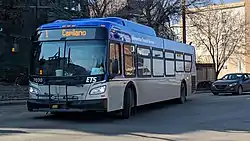 | |
| Parent | City of Edmonton |
|---|---|
| Founded | 1908 |
| Service area | Edmonton, Alberta |
| Service type | Public Transit |
| Alliance | Edmonton Metropolitan Transit Services Commission |
| Routes | 207 bus 2 LRT |
| Stops | 5,267[1] |
| Hubs | 25[1] |
| Stations | 18 (LRT)[2] |
| Fleet | 952 buses (as of 2022) 94 light rail vehicles 130 DATS vehicles[3] |
| Daily ridership | 279,600 (weekdays, Q2 2023)[4] |
| Annual ridership | 68,829,300 (2022)[5] |
| Fuel type | Bus: diesel, electric LRT: electric |
| Operator | City of Edmonton |
| Chief executive | Carrie Hotton-MacDonald (Manager) |
| Website | Official website |
History
Edmonton Transit Service began operations on 30 October 1908, under the name Edmonton Radial Railway (ERR), and alternatively as the Edmonton Radial Tramway.[6] Also in 1908, ERR acquired the Strathcona Radial Tramway Company Limited, and also began servicing the villages of North Edmonton and Calder.[6] The transit service's name was changed to Edmonton Transportation Service in July 1946, but just a year later it was re-named to Edmonton Transit System.[6] The service was re-named to Edmonton Transit Service in 2016.[6]
Streetcars

The Edmonton Radial Railway (ERR) began operations in 1908, both in the City of Edmonton and the neighbouring City of Strathcona, with four streetcars serving 21 kilometres (13 mi) of track.[7] Over ten million riders used the system annually by 1912, and the city purchased 47 additional streetcars.[7] The radial railway reached its peak in 1930, with six lines serving almost all parts of the city, and totaling 77 kilometres (48 mi) of track.[8] The city purchased five modern streetcars in 1930, which featured innovations such as steel bodies and leather seats; these were the last streetcars that Edmonton purchased.[9] The city significantly neglected its streetcar system during the Great Depression, and it suffered from poor maintenance and outdated streetcars.[9] In the late 1930s, Edmonton began to replace streetcar lines with electric trolleybus routes, supplemented by gas and diesel buses, instead of buying new streetcars and repairing or replacing the tracks and overhead lines that had deteriorated during the Depression.[9]
The transition to buses was slowed significantly during the Second World War, and Edmonton had to build additional trackage for its streetcars to meet the spike in transit usage during the war.[9] It was also forced to reintroduce conductors on busy routes, to help operators with selling tickets and issuing transfers; conductors were originally phased out in the 1930s, when streetcars were converted from double-ended to single-ended operations.[9] The Edmonton Radial Railway was renamed to Edmonton Transportation Service in 1946, to signify the decline of Edmonton's streetcar network; it was renamed again just one year later, to Edmonton Transit System.[9]
After some initial postwar hiccups, which necessitated even more streetcar tracks being built as late as in 1946 in order to avoid service gaps, the transition to trolleybuses picked up steam.[9] By 1949, only two streetcar routes remained in service: The Blue Route, and the Blue & White Route, which totaled 27 kilometres (17 mi) in length.[9] In its final configuration, the service went between a turning loop at 109 St and 84 Ave, and another loop at 66 St and 124 Ave, via the High Level Bridge.[10]
On September 1, 1951, Edmonton streetcar #1 – the first streetcar ordered by Edmonton – performed a ceremonial 'last run' across the High Level Bridge while carrying special dignitaries; over 1000 spectators lined its route.[11] Early the next morning, the dignitaries rode streetcar #52 back to the ETS Cromedale shop, which marked the final time that a streetcar was operated by ETS.[9]
All of Edmonton's streetcars, except for #1, were stripped of their valuable materials like steel and electric wiring, and the bodies were sold for scrap.[11] The Edmonton Radial Railway Society (ERRS) has recovered and restored three former Edmonton streetcars, and has another six awaiting restoration.[12] Aside from the three which it recovered and restored, it also operates Edmonton #1, which sat outside in a city yard for over ten years before being restored by volunteers – many of whom who later founded the ERRS.[9]
Trolley bus system
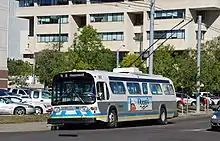
Trolley bus service in Edmonton started on 24 September 1939, operating on route 5 from 101 St/Jasper Ave to 95 St/111 Ave. By the end of October of that year, service had started on another route running to 99 St/Whyte Ave via the Low Level Bridge. In Edmonton, trolley buses were often referred to simply as "trolleys".
The trolley bus system used a mixture of Ohio Brass and K&M Elastic (Swiss) suspension for holding up the overhead wires.
The 47 vehicles remaining in use in 2008 were from an order of 100 manufactured in 1981-2 by Brown Boveri & Company (BBC), using bodies and chassis supplied to BBC by GM.
On 18 June 2008, city council voted 7 to 6 in favour of phasing out the trolley system between 2009 and 2010.[13] However, city council decided in April 2009 that trolley bus service would be discontinued earlier than had been planned, in order to reduce the city's expected $35 million deficit that year.[14] The last day of regular service was 2 May 2009.[15]
In 2007, the city leased a low-floor model of trolley, for 11 months, from Coast Mountain Bus Company, Vancouver's bus operating company, for testing of possible benefits of low-floor trolleys over hybrid diesel buses. During its time in Edmonton the bus was numbered 6000, but was returned to its original #2242 when returned to Vancouver.[16]
Service
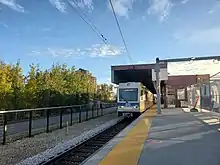
ETS provides bus and light-rail transit services within the City of Edmonton limits, in addition to Fort Saskatchewan, Spruce Grove, and Beaumont. It also provides connections to St. Albert Transit (StAT), Fort Sask Transit, and Strathcona County Transit. ETS provides service to the Edmonton International Airport, while Leduc Transit provides bus service to Leduc.
ETS uses the timed-transfer system, where suburban feeder routes run to a transit centre, and passengers can then transfer to a base route/LRT to the city centre or the university. Some feeder routes provide direct express service to and from the city centre.
Routes
LRT

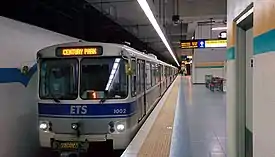 Siemens/DÜWAG U-2 car at University Station
Siemens/DÜWAG U-2 car at University Station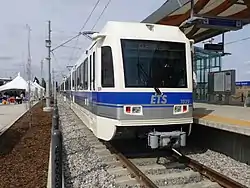 Siemens SD-160 at South Campus/Fort Edmonton Park station
Siemens SD-160 at South Campus/Fort Edmonton Park station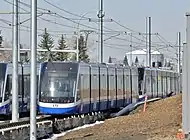
ETS operates a 20.5 km light rail system composed of eighteen stations in two lines.[17] The Capital Line runs roughly north–south, between Clareview station in northeast Edmonton and the Century Park station on the south side, with a mix of tunnels and at-grade track. Six stations are underground, while the remaining nine are at-grade with surface road crossings.[17] The Metro Line shares track with the Capital Line in some sections, and services the central and north-central area of the city.[18] The Metro Line is currently being extended to the community of Blatchford. A new LRT line, Valley Line, is scheduled to open on November 4, 2023.[19]
ETS operates two different models of light rail vehicles (LRV): The Siemens–Duewag U-2, which started service when the original line opened in 1978, and the Siemens SD-160, which began operation in 2008.[20][21] A third LRV model, the Bombardier/Alstom Flexity Freedom, is currently undergoing testing for operation on the upcoming Valley Line.[22]
Bus
A redesigned bus network that affected almost every Edmonton Transit bus route began on April 25, 2021. This redesigned bus network was originally scheduled to be implemented on August 30, 2020, but was postponed until April 25, 2021, as a result of the COVID-19 pandemic, to save approximately $3.7 million and defer tax increases for residents.[23][24]
The City of Edmonton began completely redesigning its bus route network in 2017, with the aim of making it run more efficiently. Two rounds of public consultations were held at various locations around the city, and online surveys collected feedback from riders. The public engagements identified that transit riders would rather have to walk further to get to higher frequency routes, opposed to more routes operating less frequently. The city released a final draft of the new bus system in 2018, which cut back on routes with low ridership, and increased frequency in high traffic areas. After the redesign, all routes were renumbered to make the system easier to navigate. New signage and materials was created to assist in wayfinding. No change to fares has been announced, but the Manager of ETS has stated that ETS could switch to a distance-based system, where fees are based on how far a rider travels.[25]
Late Night Owl Service

Night service began on 6 September 2015, on routes 1, 4, 8, 9, and 512.[26] Upon launch of the 2021 Bus network redesign, Owl routes are as follows: 2, 4, 8, 9, and 511. These buses operate on 30-minute headways until approximately 3:30 or 4 AM. Morning service then resumes around 5:00 AM. 2-OWL acts as a late night replacement for northern sections of the Capital Line (operating after the LRT shuts down for the night) from Clareview to Downtown.[26] 9-OWL acts as a late night replacement for southern sections of the Capital Line. Route 511 replaced 510X in September 2022, and acts as a late night replacement of the Valley Line.
Transit centres
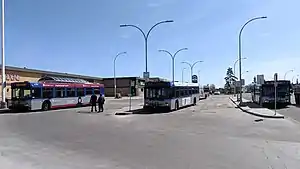
Transit Centres in Edmonton serve as hubs which allow people to transfer bus routes or onto the LRT system. These hubs typically have a heated shelter, and have multiple bus bays to accommodate many buses at a time.
- Abbottsfield Transit Centre
- Belvedere Transit Centre*
- Capilano Transit Centre
- Castle Downs Transit Centre
- Century Park Transit Centre*
- Clareview Transit Centre*
- Coliseum Transit Centre*
- Davies Transit Centre
- Eaux Claires Transit Centre
- Government Centre Transit Centre*
- Heritage Valley Transit Centre
- Jasper Place Transit Centre
- Kingsway/Royal Alex Transit Centre*
- Lakewood Transit Centre†
- Leger Transit Centre
- Lewis Farms Transit Centre
- Meadowlark Transit Centre†
- Meadows Transit Centre
- Mill Woods Transit Centre
- Northgate Transit Centre
- South Campus/Fort Edmonton Park Transit Centre*
- Southgate Transit Centre*
- Stadium Transit Centre*
- University Transit Centre*
- West Edmonton Mall Transit Centre
- Westmount Transit Centre
(* Transit Centre at LRT station)
(† As of April 25, 2021, does not have Transit Centre status)
Bus fleet
ETS operates an entire fleet of accessible low floor buses,[27] which have been progressively introduced into the system since 1993. These include the 858 40-foot (12 m) New Flyer D40LF/D40LFR/XD40, 33 60-foot (18 m) New Flyer D60LFR/XD60 articulated models, 40 40-foot Proterra ZX5 models, and 49 Grande West Vicinity B30A models.
Hybrid and electric buses
The City of Edmonton embarked on an eight-month evaluation of 13 clean-diesel and hybrid buses (and a new trolley bus) in 2008. Edmonton Transit's first two diesel electric hybrid buses went into service in December 2006.[28] The unique design and colour scheme of the two Orion low floor buses have been chosen to enable them to 'stand out' from the rest of the ETS fleet. The buses were part of an extensive test of hybrid technology that Edmonton Transit and the University of Alberta conducted over a year. Bus reliability, performance, maintenance costs, fuel efficiency, noise generation and environmental impact were monitored and evaluated in all weather and road conditions. As well, customers were surveyed about their travel experience. Ultimately, the Hybrid buses only recorded fuel savings of 10-20% (in contrast to the 35% touted in the internal ads). In addition, the ISE-New Flyer hybrids (6003 and 6004) were out of service so much that they could not be included in the evaluation.
As of fall 2009, only the two Orion hybrids were in service. New Flyer/ISE hybrids 6003 and 6004 have since been converted to diesel buses as of 2011. New Flyer/Allison 6002 was revamped with new features and technology to become the ETS Platinum Bus, also referred to as the "Painted Lady".[29]
In spring 2014, ETS unveiled a full electric bus for a four-month pilot program through October 2014. The buses were referred to as "ETS Stealth Buses" and were on lease from Build Your Dreams (BYD) Co. Ltd. The buses did not have a fare box, but instead were accepting customer surveys about electric buses as fare.[30] Even without fare capacity the buses were placed on several different routes around the city to give many Edmontonians the ability to experience the new exhaust-less bus. These test buses were not winterized.
In 2019, Edmonton received funding to purchase 50 Proterra ZX5 40' E2 MAX electric buses, but this has since been reduced to 40 electric buses – one of the largest purchases of electric buses in Canadian history.[31][32] The first 21 buses started service in August 2020, with the second batch of 19 buses being scheduled to arrive in the fall of 2020.[32] The buses are charged from overhead charging units to save floor space in the bus garages, and it is the first transit service in North America to use such infrastructure for its buses.[33][34] ETS conducted winter-testing of this bus model in 2015, and found that these buses could handle most of their routes.[32] The buses are housed at the Centennial Garage and the Kathleen Andrews transit garage; the latter being the main hub for Edmonton's electric buses.[35]
In 2021, Edmonton reached an agreement with the Canada Infrastructure Bank (CIB) which called for CIB to invest C$14.4 million (US$11.89 million) to purchase 20 additional electric buses under the ZEB (Zero Emission Bus) Federal Program. [36]
In 2022, Edmonton Transit and Strathcona Transit obtained one hydrogen-electric hybrid bus for each of the two transit systems as part of a pilot project, unveiling the new buses during the Electric and Hydrogen Vehicle Expo in Edmonton, Saturday, Sept. 24, 2022.[37][38] The pilot project is part of the Alberta Zero Emission Hydrogen Transit (AZEHT) project of Emissions Reduction Alberta.[39]
Smart bus
A new feature on ETS, Smart buses have since July 2013, seen operating on several routes, the trial routes were 111 which went from West Edmonton Mall to Downtown and 128 which went from Castle Downs to University, This system respectively used 45 buses. As of November 2014, there were 22 routes equipped.[40][41][42][43][44] Real time bus arrival information on personal computers and mobile data is branded together as ETS LIVE and a mobile app, ETS Live to Go, has been released.[40] The buses equipped possess automatic audio visual stop announcers of the next bus stop described by its nearest intersection, a computer aided dispatch which informs the control centre where a bus is, as well as monitor incidents. Mobile data terminals inform the drivers as to if they are late or not. The buses equipped have internal covert cameras to monitor safety.[45][46] City council has approved funding for Smartbus deployment on all bus routes as of 2019 and 2020.[47] All buses in the ETS fleet were fully equipped with Smart bus technology by September 4, 2016; earlier than initially planned.[48]
Fares
General fares
The table below lists fares as of 1 February 2020.[49][50] ETS currently only accepts cash for fare payments made on buses and at LRT stations. Edmonton has recently adopted a NFC enabled card for payment on ETS Busses and LRT Stations, similar to the Compass card used on the Vancouver SkyTrain operated by TransLink.
| Youth (24 and Under) | Adult (25-64) | Senior (65+) | |
|---|---|---|---|
| Cash | $3.50 | ||
| 10 Ticket Pack | $19 | $27 | $19 |
| Monthly Pass | $75 | $97 | $34 |
| Day Pass | $10.25 | ||
| Annual Pass | N/A | N/A | $374 |
Children 12 and under ride free with a fare paying adult (otherwise they must have a valid youth fare). Day passes provide unlimited travel for up to five people (maximum 2 adults over 24).[51]
ETS provides several discounts for students and the disadvantaged:
- Low income seniors can get a free annual pass.[52]
- Qualified low-income adults can purchase a bus pass for $34–48.50.[53]
- Public school and Catholic school students can purchase monthly passes from their schools at a subsidized rate.
- Post-secondary students at approved post-secondary institutions may purchase a monthly pass at a discounted rate.[54]
- Since 1 September 2007, ETS has partnered with the University of Alberta, NorQuest College, Northern Alberta Institute of Technology and MacEwan University to provide students with a Universal Transit Pass (U-Pass), allowing unlimited access to Fort Sask Transit, St Albert Transit, Strathcona County Transit and ETS bus and light rail systems for a single (four month) school term. As of 2013, University of Alberta students pay $145 after a $25 subsidy from the University of Alberta while NorQuest College, NAIT and MacEwan University students pay the full $170[55][56][57][58]
Arc card
Edmonton first approved funding for a SmartFare program in 2015.[59] Fort Saskatchewan, St. Albert, and Strathcona County are among the other communities which are also participating in this system.[60] Smart fare was set to launch in early 2021, but its rollout was delayed by the closure of the Canada-United States border during the COVID-19 pandemic.[61]
On 8 June 2021, it was announced that the SmartFare payment system would be branded as Arc.[62] Post secondary students became the first riders to use Arc when their institutions began issuing cards in fall 2021.[63] A pilot test including 500 adult fare-paying users began on 1 January 2022, and the results were reviewed in March 2022, but access to Arc was not expanded at that time.[63] Arc was rolled out to adult fare-paying riders on November 21, 2022.[64] Subsidized fare groups, including seniors, youth, junior high and senior high students, customers who purchase low-income passes, DATS riders, and users of regional paratransit services, will receive access to Arc in 2023.[64]
Fare vending machines which sell Arc cards and Arc tickets, and allow users to load money to their accounts, are located at major locations in the region, including all Edmonton LRT stations, some transit centers, and the Edmonton International Airport.[63] The machines accept cash, debit, and credit cards. Riders can also purchase Arc cards and add money to their account balances online.[63] Each rider's balance is stored on their account, rather than on the Arc cards or Arc tickets themselves, meaning that if an Arc card is lost or stolen, its balance can be transferred to a new card if the owner had registered their account.[65] Arc cards include daily and monthly fare-capping; frequent riders who reach a fare threshold will ride for the remainder of that period for free of charge.[65] Arc tickets work similarly to Arc cards, but are one-time use only, and are sold in 90-minute and 24-hour increments.[63] Riders can still pay their fare with cash, paper passes and tickets, but paper tickets and passes will eventually be phased out; cash will always be a payment option.[62]
Commuter and regional service fares
Some routes have different fare structures due to the distance they cover or because they enter different municipalities outside of Edmonton.
Spruce Grove

Fares effective 1 January 2022 for commuter routes 560 and 565 to Spruce Grove, Acheson, and:[66]
| Routes 560, 561, and 565 Local within Spruce Grove | Routes 560 and 561 To/From Edmonton | Routes 560 and 561 + ETS Transferability | |
|---|---|---|---|
| Ages 5 and Under (with a paid passenger) | Free | ||
| Cash Fare (Ages 6+) | $3 | $6.25 | N/A |
| 10 Ticket Pack | N/A | $56 | N/A |
| Monthly Pass (Ages 18+) | N/A | $135 | $197 |
| Monthly Pass (Ages 6–17 or Student) | N/A | $100 | N/A |
No additional fare for U-Pass holders.
Fort Saskatchewan

Fares effective 1 January 2021 for commuter route 580 to Fort Saskatchewan:[67]
| Route 580 Local within Fort Saskatchewan | Route 580 To/From Edmonton | Route 580 + ETS Transferability | |
|---|---|---|---|
| Ages 12 and Under (with a paid passenger) | Free | ||
| Ages 12 and Under (without a paid passenger) | $2 | $2 | N/A |
| Cash Fare (Ages 18+) | $2.50 | $5 | N/A |
| Cash Fare (Ages 13–17, 65+) | $2.00 | $4 | N/A |
| 10 Ticket Pack (Ages 18+) | $22.50 | $45 | N/A |
| 10 Ticket Pack (Ages 13–17, 65+) | $16 | $32 | N/A |
| Monthly Pass (Ages 18+) | $52.50 | $83 | $180 |
| Monthly Pass (Ages 13–17) | $22 | $37.50 | $112.50 |
| Monthly Pass (Ages 65+) | $22 | $37.50 | $71.50 |
U-Pass holders pay no additional fare. Low income riders qualify for additional discounts under the "Everyone Rides Program".
Beaumont

Fares effective 1 October 2017 for route 540 to Beaumont:[68]
| Student | Adult (13-64) | Senior (65+) | |
|---|---|---|---|
| Cash | $5 | ||
| 10 Ticket Pack | $45 | ||
| Monthly Pass | $78 | $85 | $78 |
Children under 12 ride free (with an accompanying fare-paying passenger). Beaumont tickets, passes and transfers cannot be used on regular ETS services. The U-Pass is not accepted on route 540, however the option is being considered for the future.[68]
Edmonton International Airport

Fares for route 747 to the Edmonton International Airport, effective 14 May 2018:[69]
- One way trip: $5 or two adult ETS tickets
- Monthly pass (with no transferability to regular ETS service): $90
No additional fare for holders of a UPass, Leduc Commuter-Plus pass, or Leduc route 10 to route 747 transfer
One way fare reduced back to $5 on 1 May 2018 (after it rose to $10 on 1 February 2018), when an increase in joint funding from the City of Leduc, Leduc County, and the Edmonton International Airport was agreed upon.[70]
Sherwood Park
Some Strathcona County Transit tickets/passes/transfers are valid on ETS and vice versa. These are the details effective 1 February 2018:[71]
- Sherwood Park Commuter tickets/passes/transfers are valid for use on ETS
- These are special tickets/passes/transfers purchased for or obtained from Sherwood Park commuter routes
- ETS tickets are valid on Sherwood Park commuter services for an additional $2 and on sherwood park local services for an additional $1
- Tickets for use solely on route 747 are not valid on SCT
- ETS monthly passes (excluding the seniors pass and courtesy pass) and day passes are valid on all Sherwood Park services for an additional $1
- Passes for use solely on route 747 are not valid on SCT
St. Albert
Some ETS tickets/passes/transfers are valid on StAT and vice versa:[72]
- ETS monthly passes (excluding the seniors pass and courtesy pass) are valid on all St. Albert services for an additional $1
- ETS tickets and transfers are valid on commuter St. Albert services for an additional $2
- Only valid on commuter routes between Edmonton & St. Albert
- StAT commuter tickets/passes/transfers are valid on ETS (local versions are not valid)[73]
Security
.jpg.webp)
In May 2007, Edmonton Transit Security were appointed Peace Officers under the Alberta Peace Officer Act. Transit Peace Officers can issue tickets for Provincial Statutes and Edmonton bylaws on Transit property. Transit Peace Officers actively promote order maintenance, disorder prevention and voluntary compliance with social norms surrounding acceptable transit use.[74] Transit Peace Officers use Ford Taurus police interceptors and Dodge Charger interceptors as their primary transportation, but are also seen riding the LRT enforcing bylaws. They patrol in uniform on ETS vehicles and property which include buses, LRT and transit stations 24 hours/day, 7 days/week.[75] The Transit Peace Officer Bike Patrol is also active during suitable weather conditions from spring until fall. The Bike Patrol can access certain areas better than a vehicle, such as bike paths along LRT tracks or areas congested by traffic and/or special events.[75] Transit Peace Officers are authorized to enforce municipal bylaws and have powers and authority under several provincial acts.[75]
In November 2018 Edmonton Transit added 24/7, onsite contract security guards to augment and assist the Peace Officers and Edmonton Police. The main focus of the contract security guards are to focus on high visibility patrols and observing and reporting security issues for the Transit Peace Officers or Edmonton police to attend. The contract security guards interact with the public and work closely with Transit Peace Officers and Edmonton police.[76]
In September 2021 the Transit Peace Officer group initiated a two-year pilot program called the Community Outreach Transit Team (COTT). It is a partnership between the City of Edmonton and the Bent Arrow Traditional Healing Society with the intention to aid those in need of social, medical, or financial assistance.[77]
Facilities
- Centennial Garage – bus facility: historic fleet storage; opened 24 April 2010[78]
- D.L. MacDonald Yard – LRT storage and repair facility; opened 1983
- Ferrier Garage – bus facility; formerly trolley bus barn
- Gerry Wright Operations and Maintenance Facility – LRT storage and repair facility
- Kathleen Andrews Garage – bus facility; opened 9 February 2020[79]
- Mitchell Garage – bus facility; formerly trolley bus barn; opened 7 April 1981[80]
- Paterson Garage – bus garage; bus disposal facility
- Percy Wickman Garage – Disabled Adult Transit Service (DATS) facility
Former
- Strathcona Garage – former bus/trolley bus garage (1951–1986); now home to Old Strathcona Farmer's Market and Edmonton Radial Railway Society's High Level Bridge Streetcar storage.
- Cromdale Garage – bus facility and former Edmonton Radial Railway trolley bus/streetcar barn; torn down in 2014.
- Westwood Garage – bus garage; opened 1961 and closed on 8 February 2020.[79]
Plans
Edmonton Metropolitan Transit Services Commission
The city of Edmonton began exploring the development of a regional transit services commission in 2017.[81] In February 2020, Edmonton city council voted to join twelve other municipalities to investigate the potential for a regional transit services commission (RTSC).[81] Edmonton and eight other regional municipalities, including Fort Saskatchewan, Leduc, Spruce Grove, and St. Albert, formally submitted an application to the provincial government to establish the Edmonton Metropolitan Transit Services Commission in June 2020.[82] Their proposal had to be altered after four municipalities, including Leduc County and Strathcona County, withdrew from the project.[82]
The formation of the EMTSC was approved by the Alberta government on 28 January 2021.[83] A board of elected representatives from each member community is conducting the initial setup of the commission, and working with the commission's inaugural CEO to develop its operational and planning capabilities. The EMTSC will begin service in early 2023.[84] Edmonton's local transit services and LRT network will not be transferred to the commission at first, due to their size and operational costs.[85] The commission's board will re-consider the inclusion of Edmonton's LRT network five years after the commission is formally stood up.[85]
Metro LRT
Construction on phase one of the Metro Line extension, which includes a permanent NAIT station and station for the Blatchford community on the old City Centre Airport property, started in mid-2020.[86] NAIT station current is located north of Princess Elizabeth Avenue, on the south side of the institute's swimming pool and hockey arena (S) wing.
Valley Line
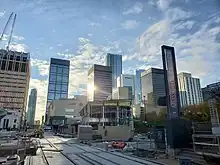
The Valley Line will run for 27 kilometres (17 mi) from Mill Woods through downtown Edmonton to Lewis Farms, with 25 stops. The 11-station segment from Mill Woods to 102 Street in downtown, known as "Valley Line Southeast", will be constructed first, beginning in 2016 and finishing by 2021.[87] Construction for phase two of the project, dubbed "Valley Line West", is expected to start in 2021.[88] Preparation work for the second phase, including property surveys, utility relocation, and land acquisition, is already underway.[89] Unlike the existing LRT, the Valley Line will run primarily at grade in the centre median of city streets, connecting to the Capital and Metro lines at Churchill station.[90] The line will cost $1.8 billion, with $800 million coming from the City of Edmonton, $600 million from Alberta, and $400 million from the federal government. A public–private partnership was established between the City of Edmonton and a private contractor to build and operate the east portion of the line.[91]
Long-range LRT plans
City council in the past has looked at creating long range transportation plans that include the LRT reaching St. Albert to the northwest, Lewis Estates in the west (with West Edmonton Mall en route), the Edmonton International Airport and Leduc to the south, Mill Woods in the southeast, and Fort Saskatchewan to the northeast.
See also
References
- "2021/2022 Annual Service Plan". City of Edmonton. Retrieved 10 March 2022.
- "2015 – 2018 Capital Budget" (PDF). Archived from the original (PDF) on 29 November 2014. Retrieved 18 November 2014.
- "ETS Statistics". City of Edmonton. Retrieved 7 April 2020.
- "Transit Ridership Report Second Quarter 2023" (PDF). American Public Transportation Association. 13 September 2023. Retrieved 21 September 2023.
- "Transit Ridership Report Fourth Quarter 2022" (PDF). American Public Transportation Association. 1 March 2023. Retrieved 29 March 2023.
- Wyatt, David A. (13 December 207). "Edmonton, Alberta". All-Time List of Canadian Transit Systems. Archived from the original on 16 January 2000. Retrieved 4 April 2021.
- "History of ETS | City of Edmonton". www.edmonton.ca. Retrieved 22 August 2021.
- "Tracks Through Time". Edmonton Community Foundation. 30 October 2019. Retrieved 22 August 2021.
- Tingley, Kenneth W. (2011). Ride of the century : the story of the Edmonton Transit System. Edmonton Transit System. Edmonton: Edmonton Transit System. pp. 107–130. ISBN 978-0-9809275-0-4. OCLC 648388316.
- "Edmonton Radial Railway Society". www.edmonton-radial-railway.ab.ca. Retrieved 22 August 2021.
- "Edmonton Streetcar System". ERRS. Retrieved 10 March 2010.
- "Edmonton Radial Railway Society". www.edmonton-radial-railway.ab.ca. Retrieved 22 June 2022.
- "Trolleys reach end of the line". Edmonton Journal. 19 June 2008. Archived from the original on 20 June 2008. Retrieved 2 October 2009.
- Landry, Frank (19 April 2009). "Mayor targets city honchos". Edmonton Sun. Archived from the original on 7 March 2012. Retrieved 5 February 2010.
- "ETS Trolley Buses". City of Edmonton. Archived from the original on 16 June 2011. Retrieved 3 October 2011.
- "Edmonton Tests new Low Floor Trolley Bus" (PDF). Transit Talk. Edmonton Trolley Coalition. 29 September 2007. Retrieved 31 August 2017.
- Edmonton, City of (30 September 2020). "LRT Stations". www.edmonton.ca. Retrieved 1 October 2020.
- Lazzarino, Dave (21 January 2015). "Edmonton's Metro Line now set to open in spring". Edmonton Sun. Retrieved 31 August 2017.
- "Edmonton's Valley Line Southeast LRT set to open Nov. 4". CBC. 24 October 2023. Retrieved 24 October 2023.
- Edmonton, City of (30 September 2020). "ETS Statistics". www.edmonton.ca. Retrieved 1 October 2020.
- "Edmonton Light Rail Transit System – Railway Technology". www.railway-technology.com. Retrieved 1 October 2020.
- "A Look at Edmonton's Valley Line Southeast". Railway-News. 11 January 2021. Retrieved 19 March 2021.
- Cook, Dustin (24 April 2020). "COVID-19: Delaying new bus network, waste program part of Edmonton's plan to lower 2020 property tax by about one per cent". Edmonton Journal. Retrieved 1 December 2020.
- Cook, Dustin (13 October 2020). "Edmonton's new bus routes to hit the streets next April following eight-month delay due to COVID-19 pandemic". Edmonton Journal. Retrieved 1 December 2020.
- Riebe, Natasha (7 November 2019). "Edmonton to roll out revamped bus network by next summer". CBC News. Retrieved 17 May 2020.
- Mertz, Emily. "5 bus routes will now run until 3 a.m.: Edmonton Transit". Global News. Retrieved 23 April 2019.
- "Accessible Vehicles". City of Edmonton. Archived from the original on 30 November 2012. Retrieved 3 February 2013.
- "Accessibility". City of Edmonton. Retrieved 31 August 2017.
- "Special Feature – ETS Platinum Bus 6002". ETS Photo Express. 8 November 2008. Retrieved 31 August 2017.
- "Edmonton transit gets two electric buses". Edmonton Sun. 5 June 2014. Retrieved 31 August 2017.
- Edmonton, City of (16 June 2019). "Electric Buses". www.edmonton.ca. Retrieved 17 June 2019.
- "Edmonton's 1st electric bus hits city streets". Global News. Retrieved 13 August 2020.
- "Edmonton debuts fleet of new electric buses". Global News. Retrieved 13 August 2020.
- Hanbury-Brown, Holly (23 July 2020). "Edmonton Transit Service Unveils Fleet Of Record-Breaking Proterra Catalyst® E2 Max Electric Buses And Innovative Electric Bus Garages". Proterra. Retrieved 13 August 2020.
- "'Smooth riding': Edmonton's first-ever battery-electric bus rolls into service". Edmonton. 4 August 2020. Retrieved 13 August 2020.
- "Canada Infrastructure Bank, Edmonton reach agreement to fund zero-emission bus purchases". Mass Transit Mag. Retrieved 10 June 2022.
- "Edmonton, Strathcona County launch pilot program for hydrogen-electric transit buses". Global News. Retrieved 24 September 2022.
- "Edmonton previews hydrogen buses at electric vehicle expo". Edmonton Journal. Retrieved 24 September 2022.
- "Alberta Zero Emission Hydrogen Transit (AZEHT)". Emissions Reduction Alberta. Retrieved 24 September 2022.
- "Five more Edmonton transit bus routes to get real time technology". Metro Edmonton. 29 October 2014. Archived from the original on 27 July 2015. Retrieved 9 March 2016.
- "Four more Edmonton bus routes to get real time technology". Metro Edmonton. 21 August 2014. Archived from the original on 9 October 2014. Retrieved 9 March 2016.
- "Four more Edmonton bus routes to launch Smart Bus technology". Metro Edmonton. 26 June 2014. Archived from the original on 10 August 2015. Retrieved 9 March 2016.
- "Two More Routes Get Smart Bus Technology". City of Edmonton. Archived from the original on 4 March 2016. Retrieved 9 March 2016.
- "Smart Bus Initiative". Archived from the original on 18 October 2014. Retrieved 29 October 2014.
- "Smart Bus Initiative Frequently Asked Questions". Archived from the original on 29 October 2014. Retrieved 29 October 2014.
- "Final five Smartbus technology to be installed on Edmonton buses as city awaits province funding". Metro Edmonton. 23 December 2014. Archived from the original on 9 August 2015. Retrieved 9 March 2016.
- Dubois, Stephanie (1 December 2014). "Edmonton council approves Smartbus funding, set to rollout in 2019". Metro Edmonton. Archived from the original on 27 July 2015. Retrieved 9 March 2016.
- "Smart Bus Project". City of Edmonton. Archived from the original on 23 June 2016. Retrieved 18 May 2016.
- "Fares". City of Edmonton. Retrieved 1 February 2020.
- Cook, Dustin (8 January 2020). "Some Edmonton transit passes for seniors double in cost in February". Edmonton Journal. Retrieved 2 February 2020.
- "Family/Day Pass". City of Edmonton. Retrieved 1 February 2020.
- Theobald, Claire (9 January 2018). "Edmonton Transit to increase price of tickets, passes in February". Edmonton Journal. Retrieved 19 March 2018.
- "Ride Transit Program". City of Edmonton. Retrieved 1 February 2020.
- "Post Secondary Pass". City of Edmonton. Retrieved 5 February 2020.
- "Non-Instructional Fees and Faculty Student Funds 2017–2018". University of Alberta. Retrieved 31 August 2017.
- "U-Pass". NAIT Students' Association. Retrieved 3 February 2013.
- "U-Pass FAQ" (PDF). Grant MacEwan University. Retrieved 2 February 2012.
- "U-Pass". NorQuest College. Retrieved 31 August 2017.
- "$30 million for new buses and fare technology". edmontonjournal. Retrieved 9 June 2021.
- England, Luke. "Fort Saskatchewan joining Smart Fare program". FortSaskOnline.com. Retrieved 23 May 2020.
- "Border closure due to COVID-19 puts brakes on Edmonton transit's smart fare system". Global News. Retrieved 20 September 2020.
- "Going digital: Edmonton reveals Arc card smart fare transit payment system". Global News. Retrieved 9 June 2021.
- Edmonton, City of (8 June 2021). "Arc (formerly Smart Fare)". www.edmonton.ca. Retrieved 9 June 2021.
- Boothby, Lauren (15 November 2022). "Edmonton's tap Arc transit cards available to adults next week". edmontonjournal. Retrieved 15 November 2022.
- Edmonton, City of (8 June 2021). "Coming soon: Arc". Transforming Edmonton. Retrieved 9 June 2021.
- "Route 560 Schedule and Map" (PDF). City of Edmonton. 1 January 2019. Retrieved 6 February 2019.
- "Transit". www.fortsask.ca. 22 March 2021. Retrieved 4 April 2021.
- "Tickets & fares". Town of Beaumont. Retrieved 3 February 2017.
- "Edmonton International Airport Service". City of Edmonton. Retrieved 14 May 2018.
- Stolte, Elise (27 February 2018). "Edmonton airport bus fare drops back to $5 as part of regional deal". Edmonton Journal. Retrieved 27 February 2018.
- "Tickets, Passes & Fares". Strathcona County. Retrieved 3 February 2018.
- "ETS & Strathcona Transit Passes". City of St. Albert. Retrieved 28 May 2018.
- "Regional Service". City of Edmonton. Retrieved 28 May 2018.
- "Transit Peace Officer Full-time | City of Edmonton".
- "Transit Peace Officers". City of Edmonton. Retrieved 23 April 2019.
- "Enhanced 24/7 security coming to 25 Edmonton transit stations Monday – Edmonton | Globalnews.ca".
- "Community Outreach Transit Team (COTT)". www.edmonton.ca. City of Edmonton. Retrieved 19 March 2022.
- Gold, Marta (11 April 2010). "ETS opens state-of-the-art garage; New $99-million bus barn is size of five football fields, first new facility in 25 years". Edmonton Journal. p. A.5.
- Antoneshyn, Alex (9 February 2020). "Westwood ETS garage officially closed, Kathleen Andrews facility operational". CTV News. Retrieved 10 February 2020.
- Edmonton Transit Service 100. City of Edmonton. 2008.
- "Edmonton city council votes to formally join push for new regional transit services commission". Global News. Retrieved 22 January 2021.
- "Regional Transit Services Commission reaches major milestone with application to the Province / City of St. Albert". City of St. Albert. Retrieved 22 January 2021.
- Dyer, Kelsey (28 January 2021). "Regional transit commission approved by the Alberta government". Edmonton. Retrieved 9 June 2021.
- "Annual Organization Board Meeting". Edmonton Metropolitan Transit Services Commission. Retrieved 1 January 2022.
- Ernst & Young LLP (22 January 2020). "Accelerating Transit in the Edmonton Metropolitan Region: Building a Regional Transit Services Commission" (PDF). City of Edmonton. Archived (PDF) from the original on 19 June 2020. Retrieved 22 January 2021.
- Edmonton, City of (23 September 2020). "Metro Line – Northwest Extension". www.edmonton.ca. Retrieved 23 September 2020.
- "'As soon as possible in 2021': Valley Line Southeast LRT construction falls slightly further off-track, city says in latest update". edmontonjournal.com. Retrieved 16 May 2020.
- "Three consortia in running for Edmonton light rail project". International Railway Journal. 31 March 2020. Retrieved 16 May 2020.
- Edmonton, City of (9 January 2020). "Keeping track: Progress on Valley Line West LRT". Transforming Edmonton. Retrieved 16 May 2020.
- "Valley Line – Stage 1: Mill Woods Town Centre to 102 Street" (PDF). Transforming Edmonton. City of Edmonton. Archived from the original (PDF) on 26 September 2014. Retrieved 8 April 2015.
- Kornik, Slav (6 November 2014). "Edmonton groups demand more info on LRT expansion". Global News. Retrieved 31 August 2017.
External links
- Official website

- A technological history of municipally owned public transportation in Edmonton, 1893-1981. Volume one | Volume two
- ETS Photo Galleries
- Edmonton LRT Projects